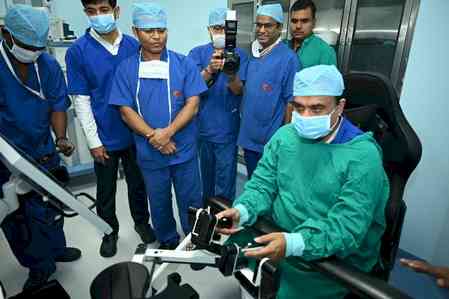AIOS releases new guidelines for operation of eye care facilities
Eye care facilities to be functional in all areas except containment zones - AIOS

New Delhi: All India Ophthalmological Society (AIOS) has recently generated new guidelines for the effective and safe functioning of ophthalmology services to the public without substituting or overriding the any statutory and ethical mandates.
While as per the earlier guidelines, ophthalmologists were undertaking only emergency surgical procedures, the new guidelines now suggest them to perform elective surgeries with due precautions. Keeping in view the significant possibility of increase in number of patients who suffer from cataract and blindness due to cataract and other eye diseases, these elective surgeries need to be started.
AIOS has said that eye care facility providers can function in all areas except in those that are labelled as containment zones by the Government authorities. Strictly enforcing and complying with preventive measures issued by the Government of India, all eye care facilities may now carry out their clinical activities including OPD, IPD and various diagnostic & surgical procedures.
“With the robust procedural framework provided in the guidelines, patients who are also equally responsible for preventing the spread of the infection are needed to strictly follow the social distancing norms and abide by the protocols of the hospitals. While we have suggested deferment of two months to undertake any outreach camps and mobile vans in orange and red zones, in order to avoid congregation of patients, through the guidelines, we also encourage the ophthalmologists to explore the potentials of Tele - ophthalmology and Teleconsultation practice in hard to reach areas.” Said Prof. (Dr) Mahipal Singh Sachdev, President AIOS & Chairman, Centre For Sight Group of Hospitals.
These being one of its kind guidelines have been drafted exclusively with expert opinions and inputs from various sub-specialties both from India and abroad. While the various Government guidelines from time to time are part of the annexures, a complete in-depth guidance for safe ophthalmology practice have been detailed. At all places the local administration and authorities has the supremacy. Guidelines have been collated in order to inform and guide the ophthalmic practitioners with the best interest of doctors, patients, healthcare staff and community in general.
Appealing to all the ophthalmic practitioners to adopt safeguards in the best interest of everyone concerned in the community, the guidelines provided by AIOS present recommendations keeping in mind the current available information and situation, and also warrants appropriate changes with the evolution and unfolding of the COVID-19 situation. Following precautionary measures as advised by the Government of India, all the patients entering the hospital must wear a mask and wash their hands and follow the social distancing measures.
“As Ophthalmologists and eye health teams work in close proximity to their patients as part of the eye examinations and treatment, and they are at particularly high risk of being exposed to the virus and contracting COVID-19. While the routine aseptic process and protocols are to be followed as usual, the main intent of framing new guidelines is to adopt to the important changes while recommissioning the OT’s during this juncture of time. The guidelines have been framed for 12 sub-specialties across ophthalmology, that also provides suggestions to restart the cornea retrieval procedures restricting it to eye banks starting Hospital Cornea Retrieval program (HCRP).” Said Dr Namrata Sharma, Hony, General Secretary, AIOS & Prof Opth RP Centre.


 cityairnews
cityairnews 








